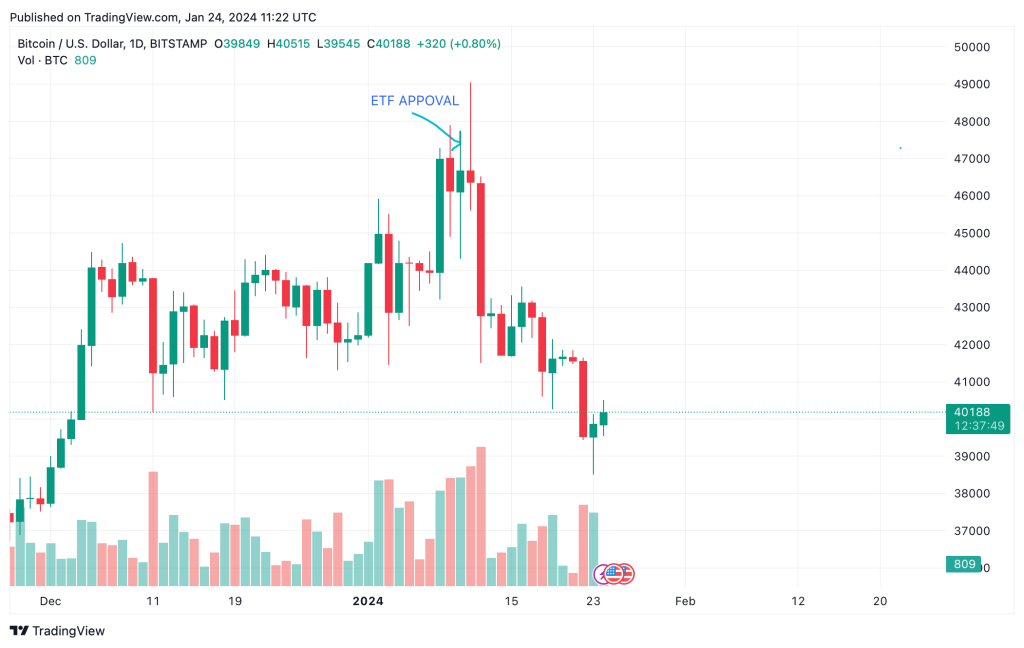The launch of the Bitcoin Exchange Traded Fund (ETF) symbolizes a turning point in the history of digital currencies by bridging the gap between the traditional financial system and the crypto world. This innovation promises to fundamentally change the landscape of digital asset investing by providing an easily accessible, regulated platform for exposure to Bitcoin without having to navigate the complexities of buying, storing and trading crypto assets directly. The implications of this development extend far beyond the immediate market reaction, touching on both short and medium-term prospects, strategic considerations for investors and future market structure. While the short-term market dynamics are characterized by volatility and adaptation, the medium to long-term outlook points to an increasing integration and acceptance of Bitcoin in the financial mainstream, supported by institutional interest and technological advances. The launch of the Bitcoin ETF is therefore not only a significant event for crypto enthusiasts, but a milestone on the road to the recognition of crypto assets as an established asset class.
Understanding the Bitcoin ETF and Its Immediate Market Effects
The launch of the Bitcoin Exchange Traded Fund (ETF) marks a milestone in the history of Bitcoin and crypto assets. The ETF allows investors to invest in Bitcoin without having to buy crypto assets directly. This provides easier access for traditional investors and could further increase the adoption of Bitcoin as an asset class.
The Role of Grayscale and Market Dynamics Post-ETF Launch
Grayscale, a leading digital asset manager, is playing a significant role in the current market dynamics. They sell approximately $500 million worth of Bitcoin every day, which puts significant selling pressure on the Bitcoin price. Interestingly, this selling pressure is largely offset by the purchases of other spot ETFs, resulting in a positive net inflow into the ETFs.

The introduction of the Bitcoin ETF has brought a new kind of dynamic to the market. On the one hand, the ETF is attracting new investors who want to invest in Bitcoin via traditional financial channels. On the other hand, the shift of investments from Grayscale to the ETF is leading to increased selling pressure on Bitcoin. However, this pressure is mitigated by the demand for the ETF, indicating that the market as a whole has reacted positively to the launch of the ETF.
Trading in the Bitcoin ETF follows a complex mechanism that affects the way transactions are settled. For example, sales of ETF shares are not immediately converted into Bitcoin transactions. Instead, there is a delay, which means that the impact of trading activity on the Bitcoin price is not felt immediately. This delayed effect is an important factor to consider when analyzing the market.
The Bitcoin ETF could contribute to greater stability and maturity of the Bitcoin market in the long term by attracting more institutional and traditional investors. This development could help reduce Bitcoin’s volatility and increase its acceptance as a legitimate asset class.
Overall, the Bitcoin ETF has ushered in a new era for Bitcoin and crypto assets. While it leads to increased volatility and complex market conditions in the short term, it could help stabilize and further integrate Bitcoin into the traditional financial system in the medium to long term. However, investors should carefully monitor the evolving market conditions and adjust their strategies accordingly as the crypto market continues to be influenced by various factors.
Short-term and Mid-term Market Outlook Following the Bitcoin ETF Introduction
Following the launch of the Bitcoin ETF, short-term effects on the market can be clearly observed. These dynamics are primarily characterized by the reallocation of investments and the behaviour of market participants.
The availability of the Bitcoin ETF has resulted in a reallocation of investments. Some investors prefer to make their Bitcoin investments via the ETF instead of investing directly in Bitcoin. This leads to a shift in capital flows in the crypto market and thus influences the price of Bitcoin.
Speculators play an important role in short-term market developments. The introduction of the ETF has led many speculators to expect the price of Bitcoin to rise. This expectation can lead to increased trading activity and therefore greater volatility.
Another factor that influences the Bitcoin price in the short term is the Bitcoin futures markets, in particular the CME exchange. High open interest indicates a high level of speculative interest. Changes in positioning on these markets can have a significant impact on the spot price of Bitcoin.
In the first quarter of 2024, various factors could lead to further selling pressure on Bitcoin. These include the activities of Grayscale, insolvency proceedings in the crypto industry and the behavior of Bitcoin miners.
Grayscale could have a significant impact on the market in the medium term. While the sale of Bitcoin by Grayscale will be offset by the purchases of other spot ETFs in the short term, the continued sale could lead to an oversupply in the medium term, which would put pressure on the price.
The insolvency proceedings of major crypto companies such as Celsius and FTX are further sources of uncertainty. If large quantities of Bitcoin are sold as part of these proceedings, this could flood the market and lead to a price collapse.
In the run-up to the next Bitcoin halving, miners could start selling their hoarded Bitcoins to secure liquidity. This would also lead to increased supply on the market and could depress the price.
The short and medium-term market outlook following the launch of the Bitcoin ETF is characterized by a mix of optimism due to increased accessibility and concerns about potential oversupply and speculative activity. Investors should monitor these developments closely and adjust their strategies accordingly. It remains important to keep an eye on both short-term market movements and medium-term structural changes in order to make informed investment decisions.
The Long-term Implications of Bitcoin ETF on Market Stability and Adoption
Investors need to carefully evaluate the ever-changing market conditions in the context of the Bitcoin ETF. This includes ongoing analysis of the market environment, trading volumes, institutional investor behavior and general market sentiment.
Given the volatility and uncertainty surrounding the launch of the ETF, robust risk management is critical. Investors should diversify their portfolios, use stop-loss orders and carefully monitor their investments to minimize potential losses.
Despite short-term uncertainties, long-term investors could benefit from the increasing acceptance and integration of Bitcoin into the traditional financial system. A long-term perspective can help weather short-term market volatility.
The introduction of the ETF could lead to increased participation by institutional investors, which could change the market structure of Bitcoin in the long term. This may lead to increased market stability and a decrease in volatility.
The reaction of the regulatory authorities to the Bitcoin ETF and related products will be an important factor for the future development of the market. Positive regulatory developments could strengthen confidence in Bitcoin as an asset class.
Technological advances in blockchain technology and the crypto space could further increase the attractiveness of Bitcoin as an investment. This includes improvements in the scalability, security and user-friendliness of Bitcoin transactions.
The further integration of Bitcoin into the traditional financial system, for example through the introduction of further crypto ETFs or the acceptance of Bitcoin as a means of payment, could further increase the value and acceptance of Bitcoin.
The Bitcoin ETF opens a new era for Bitcoin and offers both opportunities and challenges. While short-term turbulence can be expected, long-term trends point to continued acceptance and maturation of Bitcoin as an asset class. However, investors should remain vigilant and continually adapt their investment strategies to changing market conditions. The key to success lies in a balanced combination of prudent analysis, strategic planning and a deep understanding of market mechanisms.
Final Thoughts
The launch of the Bitcoin ETF represents a significant step in the evolution of the cryptocurrency market. This step not only symbolizes the growing acceptance of Bitcoin in traditional financial circles, but also marks the beginning of a new era for investors and the market as a whole.
In the short term, the introduction of the ETF has led to significant shifts and increased volatility. Selling pressure from large players such as Grayscale has been partially offset by demand for new spot ETFs, indicating a complex but robust market structure.
Challenges lie ahead in the medium term, mainly influenced by potential selling by large Bitcoin holders such as Grayscale, bankruptcy proceedings of crypto companies and the behavior of Bitcoin miners ahead of the next halving. These factors could flood the market with additional supply of bitcoins, putting pressure on the price.
In the long term, however, the ETF offers a promising prospect for the integration of Bitcoin into the traditional financial system. With increasing institutional participation and positive regulatory developments, the market could stabilize and reduce Bitcoin’s volatility. Technological advances in blockchain technology could also further increase the attractiveness of Bitcoin.
Overall, the Bitcoin market is at a critical juncture. While there are uncertainties in the short and medium term, the long-term picture is one of hope and potential. For investors, this means that careful monitoring of market developments and flexible adjustment of investment strategies are essential. The Bitcoin ETF could prove to be a catalyst for the further development and maturity of Bitcoin, firmly anchoring the cryptocurrency in the world of traditional financial assets.
If you liked this article, you might also be interested in the following: Future prospects of the Bitcoin market after the spot ETF launch: The Importance of the Possible Bitcoin Spot ETF Release
Author
Ed Prinz is co-founder and CEO of https://loob.io. The platform serves as a digital marketplace for digital assets that are secured using blockchain technology. On this platform, digital assets can be created, displayed in a gallery and traded on a marketplace. Everything is completely decentralized via smart contracts on the public blockchain. Usage rights are also secured on the blockchain, as is the entire trading history. He also serves as chairman of https://dltaustria.com, the most renowned non-profit organization in Austria specializing in blockchain technology. DLT Austria is actively involved in the education and promotion of the added value and possible applications of distributed ledger technology. This is done through educational events, meetups, workshops and open discussions, all in voluntary collaboration with leading industry players.
👉 Telegram
👉 Website
Disclaimer
This is my personal opinion and not financial advice, therefore I cannot guarantee the accuracy of the information in this article. If you are unsure, you should consult a qualified advisor you trust. No guarantees or promises regarding profits are made in this article. All statements in this and other articles are my personal opinion.

